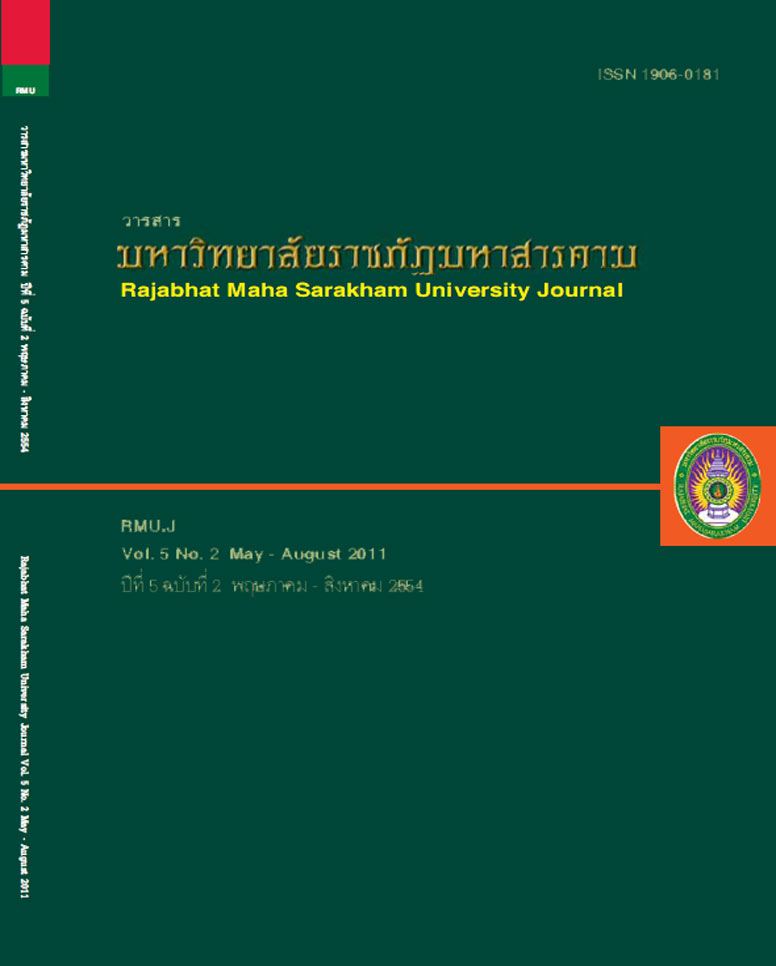การพัฒนากิจกรรมการเรียนรู้โดยใช้แบบฝึกทักษะการอ่านสะกดคำภาษาไทย ชั้นประถมศึกษาปีที่ 1 โรงเรียนบ้านโพธิ์เงิน
Main Article Content
Abstract
การวิจัยในครั้งนี้มีวัตถุประสงค์ ประการแรก เพื่อพัฒนากิจกรรมการเรียนรู้โดยใช้แบบฝึกทักษะการอ่านสะกดคำ
ภาษาไทย ชั้นประถมศึกษาปีที่ 1 โรงเรียนบ้านโพธิ์เงิน ที่มีประสิทธิภาพตามเกณฑ์ 80/80 ประการที่สอง เพื่อหาค่าดัชนี
ประสิทธิผลของกิจกรรมการเรียนรู้ ประการที่สาม เพื่อเปรียบเทียบผลสัมฤทธิ์ทางการเรียนของนักเรียนชั้นประถมศึกษา
ปีที่ 1 ระหว่างก่อนและหลังเรียนรู้ด้วยกิจกรรมการเรียนรู้ ประการที่สี่ เพื่อศึกษาความคงทนในการเรียนรู้ของนักเรียนที่
เรียนรู้ด้วยแบบฝึกทักษะการอ่านสะกดคำภาษาไทย และประการที่ห้า เพื่อศึกษาความพึงพอใจในการเรียนรู้ของนักเรียน
ที่เรียนรู้ด้วยกิจกรรมการเรียนรู้โดยใช้แบบฝึกทักษะการอ่านสะกดคำภาษาไทย กลุ่มเป้าหมายเป็นนักเรียนชั้นประถมศึกษา
ปีที่ 1 โรงเรียนบ้านโพธิ์เงิน สำนักงานเขตพื้นที่การศึกษามหาสารคาม เขต 1 ภาคเรียนที่ 2 ปีการศึกษา 2551 จำนวน
6 คน เครื่องมือที่ใช้ในการวิจัย ได้แก่ แผนการจัดการเรียนรู้การอ่านสะกดคำภาษาไทย จำนวน 20 แผน แบบฝึกทักษะ
การอ่านสะกดคำภาษาไทย จำนวน 20 ชุด แบบทดสอบวัดผลสัมฤทธิ์ทางการเรียน ชนิดเลือกตอบ 3 ตัวเลือก จำนวน 30 ข้อ
และแบบศึกษาความพึงพอใจของนักเรียนที่มีต่อการพัฒนากิจกรรมการเรียนรู้โดยใช้แบบทักษะการอ่านสะกดคำภาษาไทย
ชนิดมาตราส่วนประมาณค่า (Rating scale) 5 ระดับ จำนวน 15 ข้อ สถิติที่ใช้ได้แก่ ร้อยละ ค่าเฉลี่ย ส่วนเบี่ยงเบนมาตรฐาน
ผลการวิจัยพบว่า
1. ประสิทธิภาพของกิจกรรมการเรียนรู้โดยใช้แบบฝึกทักษะการอ่านสะกดคำภาษาไทย ชั้นประถมศึกษาปีที่ 1
มีประสิทธิภาพเท่ากับ 84.83/83.89 ซึ่งสูงกว่าเกณฑ์ 80/80 ที่ตั้งไว้
2. ดัชนีประสิทธิผลของกิจกรรมการเรียนรู้โดยใช้กิจกรรมการเรียนรู้แบบฝึกทักษะการอ่านสะกดคำภาษาไทย ชั้น
ประถมศึกษาปีที่ 1 มีค่าเท่ากับ 0.6027 คิดเป็นร้อยละ 60.27
3. ผลสัมฤทธิ์ทางการเรียนรู้ที่เรียนด้วยกิจกรรมการเรียนรู้โดยใช้แบบฝึกทักษะการอ่านสะกดคำภาษาไทยสูงกว่า
ก่อนเรียนอย่างมีนัยสำคัญทางสถิติที่ระดับ .05
4. นักเรียนที่เรียนรู้ด้วยกิจกรรมการเรียนรู้โดยใช้แบบฝึกทักษะการอ่านสะกดคำภาษาไทย มีคะแนนเฉลี่ยหลังจาก
การทดสอบหลังเรียนไปแล้ว 2 สัปดาห์ ไม่แตกต่างจากความรู้หลังเรียน ซึ่งแสดงว่านักเรียนมีความคงทนในการเรียนรู้
5. ความพึงพอใจในการเรียนรู้ด้วยกิจกรรมการเรียนรู้โดยใช้แบบฝึกทักษะการอ่านสะกดคำภาษาไทย โดยรวมอยู่ใน
ระดับมาก และมีความพึงพอใจเป็นรายข้ออยู่ในระดับมากถึงมากที่สุด
This study aimed to 1) develop exercise-assisted instruction in reading-aloud spelling of Thai
words for Prathomsuksa I students of Ban Poe-Nguen School that meets the required 80/80 efficiency,
2) find the effectiveness index of the Exercise-Assisted Instruction developed by the researcher,
3) compare the students’ achievements before and after learning through the Exercise-Assisted
Instruction, 4) study students’ retention after learning through Exercises-Assisted Instruction, and
5) study the students’ satisfaction.
The sample consisted of 6 students for 1st grade education studying in the second semester of
the academic year 2007 at Ban Poe-Nguen School, Mahasarakham Educational service Area Office 1.
The instruments used in the study were 20 lesson plans, a 30-item 3-choice learning achievement test,
and a 15- item 5-scale questionnaire on the students’ satisfaction. The statistics used for analyzing
data were percentage, mean, and standard deviation.
Findings of the study are as follows:
1. The efficiency of the lesson plans using the Exercise-Assisted Instruction in reading-aloud
spelling of Thai words for Prathomsueksa I students was 84.83/83.89, which was higher than the
established 80/80 criterion.
2. The effectiveness index was 0.6027, meaning the students’ learning increased 60.27%
3. The students’ posttest learning achievement was significantly higher than that of the pretest
at .05 level.
4. Test of the students’ retention taken 2 weeks after the posttest revealed no significant difference
in knowledge tested after the learning.
5 The students’ overall satisfaction with the Exercise-Assisted Instruction was found at a high
level, with average mean of satisfaction for specific items ranging from high to highest.
Article Details
1. All articles undergo a thorough with at least three reviewers evaluating their suitability within the respective field of study, during the double-blind review.
2. The views expressed by individual authors do not represent the official views of the Editorial Boards of RMUJ: The author of each articie is responsible for all its contents.
3. The Editorial Boards do not reserve the copyrights. but proper citations need to be made.


